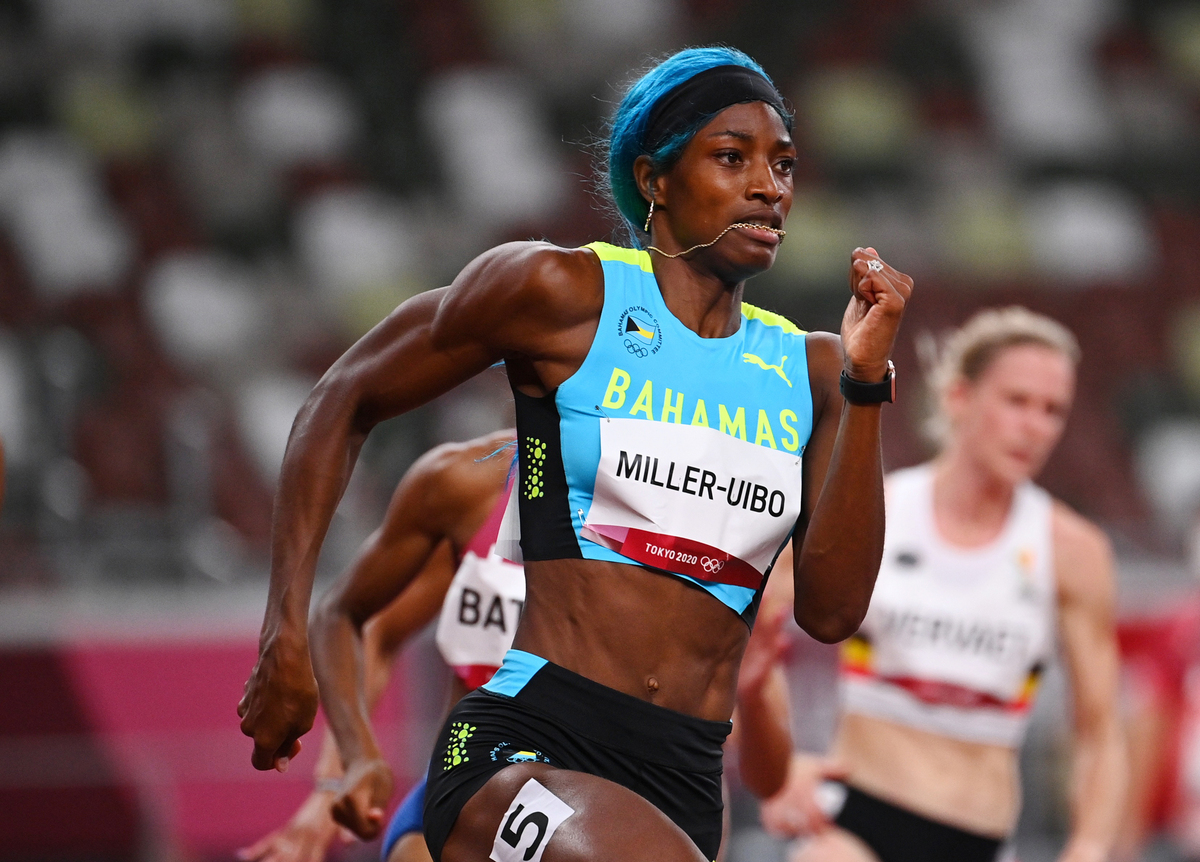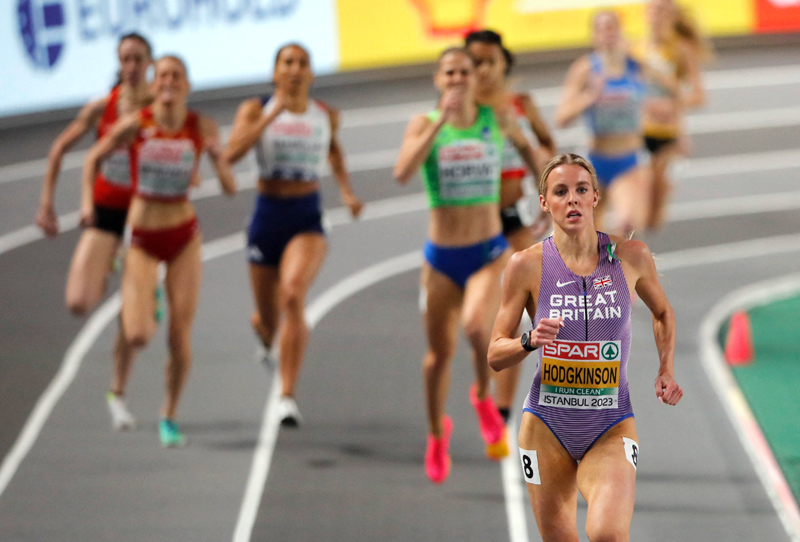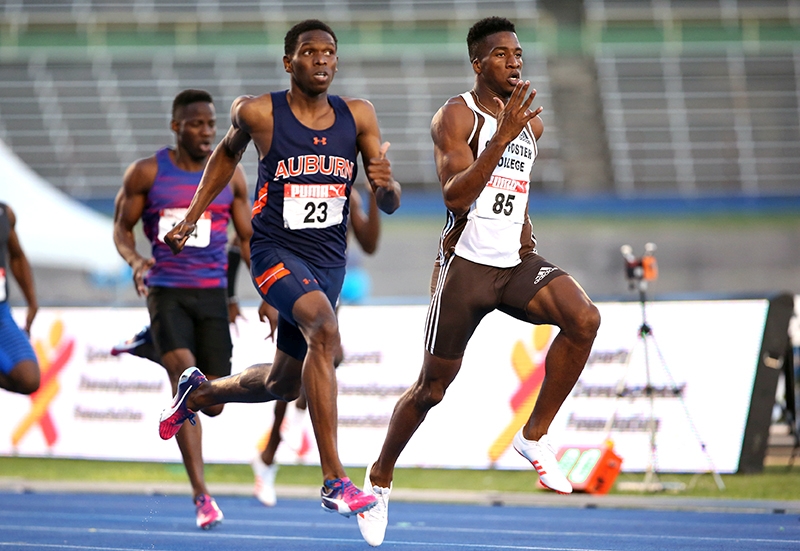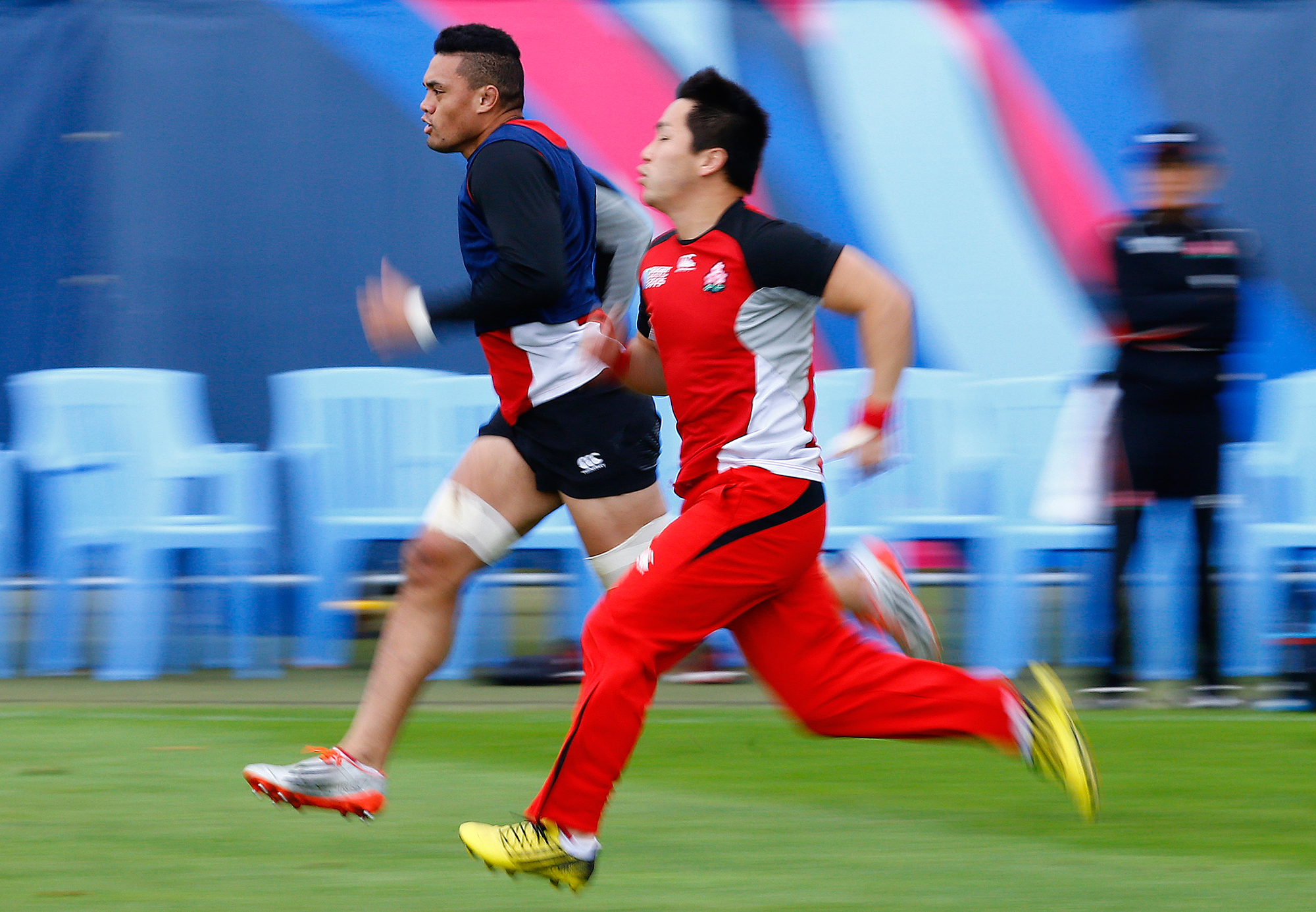You are viewing 1 of your 1 free articles. For unlimited access take a risk-free trial
High-intensity training: are sprint intervals overhyped?
Short, high-intensity sprint intervals are popular for boosting aerobic fitness. But how do they stack up against more conventional longer-duration intervals? SPB looks at brand new research
Whatever your endurance sport, it’s a fact that grinding out steady state, one-pace workouts will only really produce performance gains in the earlier stages of training. Once you reach the performance plateau that one-paced training inevitably brings, you need to challenge the muscles and the aerobic energy systems in your body in order to produce further gains in aerobic capacity and power.
Probably the most popular way of providing this challenge is with the use of interval training, where training sessions consist of a number of high-intensity efforts of a predetermined duration interspersed with short periods of rest. First described by German researchers Reindell and Roskamm, interval training was popularized in the 1950s by the Olympic champion, Emil Zatopek. More importantly, there’s excellent empirical evidence that a wide variety of interval training protocols (ie varying interval durations and intensities) are effective for enhancing the efficiency of both the aerobic and anaerobic energy producing systems in the muscles(1), and this helps to explain why intervals are now used so widely.
How are interval durations determined?
Until the late 1990s, most endurance athletes performing intervals relied on interval durations that reflected the demands of their event. Since endurance efforts lasting more than around two minutes – ie most endurance events - rely very heavily on the aerobic energy producing system(2), and efforts of up to 10 minutes require over 90% of energy demands to be met from the aerobic energy system(3), this meant that interval sessions were typically modeled around intervals lasting from 2-10 minutes.
Accordingly, aerobic high-intensity interval training (abbreviated HIIT) using intervals of 3-5 minutes became a popular and well-documented method for athletes and fitness enthusiasts seeking to improve aerobic fitness and endurance performance(4). The rationale for this approach is that a high overload of the oxygen transportation system and of the muscles utilizing the delivered oxygen can only be achieved after a couple of minutes or so because of sluggish ‘oxygen kinetics’ (ie the delay between starting a high-intensity effort and the cardiovascular system and muscles ‘catching up’)(5). However, too long an interval, and the accumulated fatigue means that repeated interval efforts are not possible, which sets an upper limit to the length of each interval to around 8-12 minutes(6). This explains the recommendations that intervals should be between these limits, and towards the lower end (eg 4-minute intervals) if repeated several times.
The rise and rise of sprint intervals
The principle of matching the interval length and intensity to the energy demands of an event makes sense, not least because it’s based on sound scientific principles. What’s interesting however is that a large body of recent research suggests that athletes can also benefit from interval sessions that don’t appear to fit these principles. Even more intriguingly, there’s good evidence that endurance athletes whose events rely primarily on aerobic energy production can actually benefit greatly from short, intense interval repeats of under a minute, sometimes referred to as ‘sprint intervals’.
The birth of high-intensity sprint-type intervals as a productive mode of training for endurance athletes stems from earlier research by a Japanese professor called Izumi Tabata of the National Institute of Fitness and Sports in Kanoya, Japan. In a revolutionary study published in 1997, Tabata designed a scientific study for a protocol that was already being used by Japanese speed skaters(7).
Tabata’s study compared two groups of athletes over a 6-week period. In the study, the first group of athletes engaged in one hour of steady-state, moderate-intensity (70% of maximum oxygen uptake - VO2 max) endurance training on a stationary bicycle for five days each week. The second group meanwhile followed a protocol similar to the one already being used by Japanese speed skaters. This second group also did their work on a stationary bicycle but with a very different structure: after a 10-minute warm up, they engaged in a 4-minute period of eight intervals with a 2:1 ratio between work and rest (ie 8 sets of 20 seconds of work followed by 10 seconds of rest).
During the work phase, intensity was kept very high at 170% of VO2 max - in other words, at an intensity well in excess of what the athletes could have sustained over a longer period - with pedalling speeds at 90 rpm.
When the researchers analysed the results, the first finding was that (perhaps unsurprisingly), the Tabata method of training resulted in improvements to the athletes’ anaerobic capacity whereas the steady-state trained athletes made no such gains. Given that the Tabata-trained athletes worked for short periods of time at levels that greatly exceeded their aerobic capacity – ie trained anaerobically - this makes perfect sense.
However, the Tabata-trained athletes also made substantial gains in maximum oxygen uptake (VO2 max), particularly during the first half of the experiment. This indicated that the very short, high-intensity protocol had actually been able to boost aerobic endurance as well as anaerobic performance, equalling the gains achieved by the steady state group.
The key finding from this study was that sprint-type interval sessions can produce good gains in aerobic fitness even though the training itself is not what we would think of as aerobic type training. Another (and very important) benefit of this mode of training was that compared to the steady state group, less time was required to produce equivalent aerobic gains in the sprint-interval group.
Tabata concluded that his protocol worked because it was able to stress both the aerobic and anaerobic energy releasing systems maximally. Subsequent research has confirmed that in sprint type intervals, although the aerobic intensity and oxygen demand of each interval is not particularly high (due to the slow oxygen uptake kinetics), by keeping the recovery intervals in between each interval effort short, the overall aerobic intensity through the session can be raised because there’s insufficient time to repay the oxygen debt. This in turn means the body has to respond by getting better at delivering and using oxygen (exactly what happens during steady state training), which is why high-intensity sprint-intervals can be an effective tool for developing aerobic fitness(8).
HIIT vs. sprint-type intervals: let battle commence
As we’ve discussed above, data shows that high-intensity intervals (typically lasting around 4 minutes duration per interval) and sprint-type intervals (10-30 seconds per interval) are both able to elicit good gains in maximum oxygen uptake – possible the single most important factor for long-distance running performance - and consequently, endurance performance. The obvious question is which one is best for endurance athletes seeking to improve and maximize performance? The data shows that sprint-type anaerobic intervals can rival or exceed the gains made from steady-state training. But can sprint intervals produce equivalent aerobic fitness gains compared to longer intervals run at high aerobic intensities?
Bearing in mind the ‘specificity of training principle’, you might assume that longer, high-intensity aerobic intervals would be superior for aerobic endurance performance. But given that a session of sprint type intervals is very time efficient, this mode of training could be preferable when time is tight. Moreover, if a session of sprint intervals is conducted with very minimal rest periods in between each effort, could the overall oxygen demand produce an equivalent aerobic training effect? What is needed is a carefully controlled study comparing these interval protocols, because data on this topic is actually quite scarce. The good news is that this is exactly what a team of Norwegian scientists has just done.
New research
In this study, which was published in the Scandinavian Journal of Medicine and Science in Sports, researchers at Trondheim University investigated three different interval-training protocols in 48 well-trained runners to see how they impacted oxygen uptake, aerobic endurance, anaerobic capacity and running performance – both distance and sprint performance(9). The protocols consisted of longer high-intensity intervals, and two types of sprint intervals, one with minimal rest between efforts and one with longer rests between intervals. These were performed three times per week for eight weeks. In detail, these protocols were as follows:
*High-intensity intervals (4 x 4mins): The high-intensity interval group performed 4 x intervals of 4 minutes’ duration at around 95 % of their maximum sustainable aerobic speed (MAS), aiming to produce a heart rate equivalent to 90-95 % of heart rate maximum (HRmax) within three minutes of commencing each interval. The intervals were separated by three minutes of active recovery, which involved slower paced running at an intensity corresponding to 70 % of HRmax, and finally three minutes of cooling down at the same intensity at the end of the session. Throughout the each training session, treadmill speed was regularly adjusted to reach the target heart rate within three minutes of starting every interval. Including the warm up and cool down, the 4x4min protocol lasted 38 minutes.
*Sprint intervals with minimal rest (8 x 20secs): These sessions consisted of around 8 x 20-second intervals at around 150% of MAS, separated by only ten seconds of passive rest (ie no gentle running), aiming to exhaust the subject during the eighth or ninth interval. If a ninth interval was completed, the velocity was slightly increased in the following training session. All the runners had one-to-one follow-up and received verbal encouragement during all the intervals, ensuring that absolute exhaustion was attained. Including the warm-up and a 10-minute cool down at an intensity corresponding to 70% of HRmax, the sprint interval 8x20sec protocol lasted around 25 minutes, including a warm up and 10-minute cool down.
*Sprint intervals with long rests (10 x 30secs): This protocol consisted of 10 x 30 seconds running intervals of maximal effort separated by active rest periods of 3.5 minutes (ie long) at 70% of HRmax or below. The starting workload during the first session was calculated to represent each subject’s average workload from their 300-meter performance. If necessary, the intensity within a training session was gradually reduced from interval to interval in order to ensure the runners could maintain durations of 30 seconds per intervals (the fatiguing intensity of a 30-second maximal print cannot be maintained for 10 consecutive bouts). The average interval intensity during a training session was around 175 % of MAS. As above, during all intervals, every subject had one-to-one follow-up and received verbal encouragement, ensuring that the intensity was maximal during every single interval. The total duration of each session was 49 minutes including a warm up and a 3-minute of cool down (gentle running at less than 70% of HRmax).
Before and after the 8-week interval training intervention, four key aerobic fitness and running performance parameters were measured. These were as follows:
- Maximal oxygen uptake (VO2max)
- Oxygen pulse (basically, the amount of oxygen pumped per kilo of bodyweight per heartbeat)
- 3000m running performance (a test of aerobic endurance)
- 300m (a test of anaerobic/sprint performance)
Any runner who failed to complete at least 80% of the 24 training sessions over the 8-week period for whatever reason was excluded from the analysis.
What they found
Following a statistical analysis of the data, the results showed the following:
- VO2max increased by 6.5% in the 4 x 4min intense intervals compared with just 3.3% in the 8 x 20secs sprint intervals and no significant gains in the 10 x 30secs sprint intervals.
- A similar pattern was found in oxygen pulse; in the 4 x 4min intervals, oxygen pulse increased by a whopping 8.1%, compared to 3.8% in the 8 x 20secs intervals and no significant change in the 10 x 30secs intervals.
- Long-distance (3000m) running performance improved in all three protocols, but once again the 4 x 4mins intervals were superior, producing time improvements of 5.9% compared to 3.7% and 2.2% for the 8 x 20secs and 10 x 30secs protocols respectively.
- The only parameter that favored the sprint protocols was 300m running performance, where the 8 x 20secs and the 10 x 30secs protocols produced time improvements of 4.4% and 3.3% respectively, with the 4 x 4mins protocol producing non-significant gains.
Figure 1 summarizes the findings in graphical form.
Figure 1: Percentage improvements following the interval interventions
Related Files
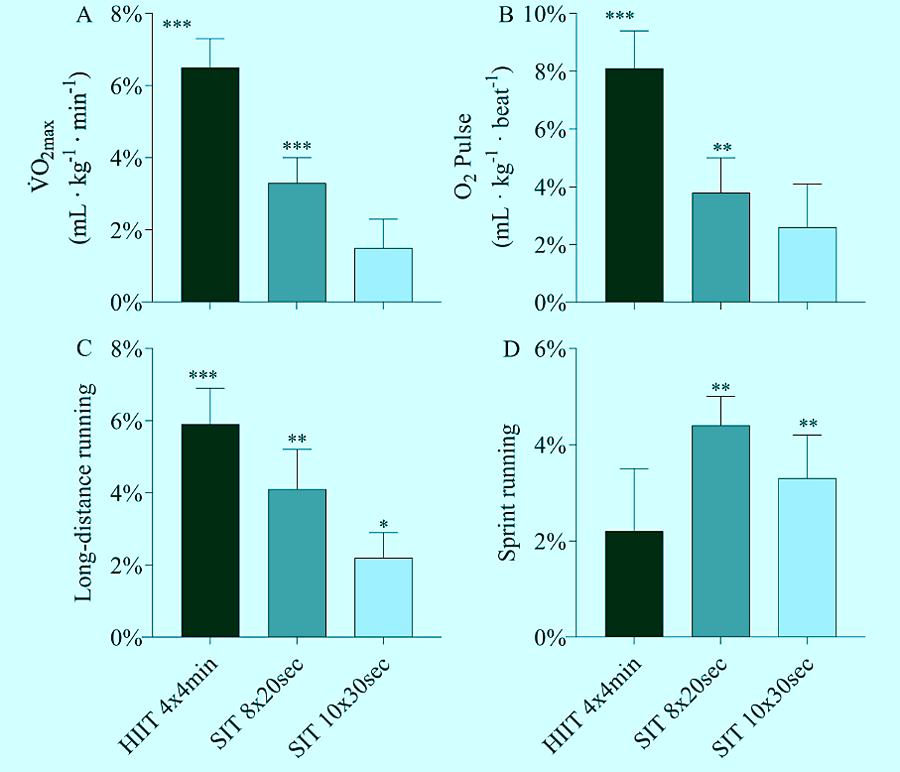
Implications for athletes
These findings are important and have significant implications so let’s unpack them carefully. Firstly, this is the first study to definitely show that for endurance performance, high-intensity intervals of the more traditional type (4 x 4mins) are superior to sessions of sprint intervals based on Tabata protocols. In a nutshell, if you want to maximize your endurance performance in events lasting 10 minutes or more (to be honest, most events), performing longer, high-intensity interval sessions is going to get you better results than sprint-interval training.
The second finding is that while longer high-intensity intervals are superior, short sprint intervals along the lines of 8 x 20secs with minimal rest in between intervals are not without merit. They still produced significant gains in aerobic endurance, which although not as large as the longer intervals, were still meaningful. Importantly, these sessions can be completely in a shorter timeframe, which could be an advantage where time is tight. Note however that performing 30-second intervals with long recovery periods in between does not seem to offer any significant benefits.
Thirdly, while longer high-intensity intervals are superior for endurance, they didn’t produce any gains in sprint/300m performance. Given that many endurance events require a mid-race kick or a long sprint to the finish line, training this ability is definitely worthwhile, especially for shorter endurance events requiring high-intensity bursts. This suggests that while longer high-intensity intervals should form your mainstay of interval training, the inclusion of sprint intervals – especially of the 8 x 20secs with minimal rest variety.
However, all sprint intervals are not equal and it would seem that the 10 x 30secs protocol with relatively long rest periods in between has little to offer endurance athletes. This is most likely because these intervals allow the heart rate and oxygen transport system to slow significantly in between efforts, meaning that very little time is accumulated near to VO2max, something that is known to be important for producing endurance performance gains(10-12).
A final point worth making here is that in this study, the sprint interval protocols came at a perception price. Although these runners were well-trained and had good-to-high maximum oxygen uptake capacities (50+mls/kg/mins), the sprint intervals resulted in several non-severe adverse effects, such as nausea, vomiting and dizziness. Okay, they were being pushed to the max by their one-to-one trainers, but these kinds of reactions are not conducive to training adherence! Indeed, of the 24 training sessions planned, the compliance was 98% for the long interval group, 95% for the 8 x 20secs group and just 89% for the 10 x 30secs group.
In summary, maybe we’ve come full circle in the interval-training debate. Sprint intervals certainly have their benefits but it seems the old-school approach could be better for endurance athletes after all!
References
- Sports Med. 2001;31(1):13-31,
- Journal of Sports Medicine and Physical Fitness. May 2015;55(5):377-82
- J Sports Sci. Oct 2005;23(10):993-1002
- Med Sci Sports Exerc. Apr 2007;39(4):665-71
- J Appl Physiol (1985). Jul 2002;93(1):167-74
- Eur J Appl Physiol. Jun 2000;82(3):178-87
- Med Sci Sports Exerc 1997; Volume 29(3), pp 390-395
- Scand J Med Sci Sports. Oct 2009;19(5):687-94
- Scand J Med Sci Sports. 2022 Oct 31. doi: 10.1111/sms.14251. Online ahead of print
- Eur J Appl Physiol. Jul 2019;119(7):1513-1523
- Physiol Behav. May 15 2018;189:10-15
- Eur J Appl Physiol. Feb 2012;112(2):767-79
Newsletter Sign Up
Testimonials
Dr. Alexandra Fandetti-Robin, Back & Body Chiropractic
Elspeth Cowell MSCh DpodM SRCh HCPC reg
William Hunter, Nuffield Health
Newsletter Sign Up
Coaches Testimonials
Dr. Alexandra Fandetti-Robin, Back & Body Chiropractic
Elspeth Cowell MSCh DpodM SRCh HCPC reg
William Hunter, Nuffield Health
Keep up with latest sports science research and apply it to maximize performance
Today you have the chance to join a group of athletes, and sports coaches/trainers who all have something special in common...
They use the latest research to improve performance for themselves and their clients - both athletes and sports teams - with help from global specialists in the fields of sports science, sports medicine and sports psychology.
They do this by reading Sports Performance Bulletin, an easy-to-digest but serious-minded journal dedicated to high performance sports. SPB offers a wealth of information and insight into the latest research, in an easily-accessible and understood format, along with a wealth of practical recommendations.
*includes 3 coaching manuals
Get Inspired
All the latest techniques and approaches
Sports Performance Bulletin helps dedicated endurance athletes improve their performance. Sense-checking the latest sports science research, and sourcing evidence and case studies to support findings, Sports Performance Bulletin turns proven insights into easily digestible practical advice. Supporting athletes, coaches and professionals who wish to ensure their guidance and programmes are kept right up to date and based on credible science.
